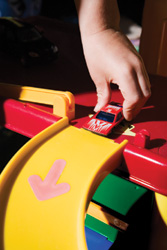
The history of toy and other product recalls stretches back to the 1970s, when the Consumer Product Safety Commission was formed. The CPSC has jurisdiction over more than 15,000 products—nearly every consumer item that isn’t a motor vehicle, food, drug or cosmetic. One large part of the CPSC’s jurisdiction is the toy market.
Toy recall stories have been making headlines recently, primarily due to the severity of some toys’ dangers. Last year, a child’s death resulted in a massive recall of Magnetix magnetic building sets. The toy’s small magnets could detach and be ingested, linking together in a child’s intestines and causing severe internal injuries. In November, several children suffered severe side effects after swallowing pieces from the popular craft kit Aqua Dots. The pieces were coated in a hazardous chemical which, when ingested, caused a reaction similar to a date rape drug. In addition to these major incidents, there has been a swell of products recalled because they contain harmful levels of lead.
Analysts have been quick to notice one common element in many of the recalls—the majority of the toys are manufactured in China. In June, the New York Times reported that China had manufactured every single toy recalled for safety reasons in 2007. And that number has only gone up since then.
Beginning last June with the recall of more than 1.5 million Thomas & Friends railway toys for containing excessive levels of lead, there have been major recalls nearly every month. In July, nearly a million Easy-Bake Ovens were recalled after children caught their fingers and hands in the oven’s opening, causing burns, cuts and in one case, a partial amputation. That same month, 21,000 Sky Rangers Park Flyer remote-controlled toy airplanes were recalled after 45 cases were reported of the planes exploding.
In August, industry giant Mattel recalled over 10 million toys, including popular Barbie, Polly Pocket and Cars movie items, as well as many Fisher-Price infant toys. Mattel’s recalls were again due to high levels of lead in the toys’ paint and small parts which could detach and be swallowed. The recalls continued for Mattel through the next two months, including more Barbie accessories and Fisher-Price toys. Then came November, when children who swallowed pieces from the Aqua Dots craft kit were hospitalized for severe side effects, including vomiting and unconsciousness. More than four million toy kits were removed from shelves and homes in North America and Australia, but not before five children were hospitalized.
Just like the toys recalled in the first half of 2007, these toys were all manufactured in China. It has been reported that some of the hazards are the result of cost-cutting techniques used by toy factories. Lead paint, for example, produces brighter colors and is durable, flexible and very cost-effective. The dangerous chemical in Aqua Dots is a less expensive alternative to the nontoxic chemical that was supposed to be used.
With the recent surge in recalls, representatives from one of China’s product safety watchdogs stated that they plan to increase communication and strengthen cooperation between the U.S. and China’s manufacturers. The Chinese government has banned several manufacturers from exporting their products and even shut down one company responsible for supplying lead-tainted toys to Mattel.
While there is clearly a problem, recent findings indicate that there may be misconceptions regarding Chinese-made toys. In November, a Canadian study found that proportionally, toys made in China are no more dangerous than toys manufactured in other countries. Because China is responsible for more than 85 percent of toys imported by the U.S., it is normal for so many recalled toys to have originated from there.
Mattel has pointed out another misconception affecting Chinese manufacturers—that many recalls are the fault of toy design, not manufacturing. The company issued an apology to China following its massive toy recall in August, stating that a vast majority of the recalls were the result of Mattel’s own design flaws, not Chinese manufacturers’ lead paint violations.
The recall surge has caused a ripple effect of inconvenience, anger and fear. Major toy companies have had to take hundreds of thousands of products off the market and reimburse customers. Some Chinese toy manufacturers and suppliers have been forced to close their doors permanently. Consumers and retailers alike had to take extra precautions against dangerous toys when entering the holiday shopping season. Even holiday charities suffered— extra time and volunteers were needed to sort through donations and remove recalled items. MSNBC reported that many charities were forced to spend money and purchase their own toys so children wouldn’t be disappointed.
It isn’t yet time to lose all faith in toys. With toy safety awareness becoming an ever-prevalent topic, the situation is on its way to improvement, reports the Toy Industry Association. The association’s website, ToyInfo.org, advises parents to stay informed and trust that the industry is taking steps to increase toy safety. According to the website, the toy industry is also in the process of developing a mandatory testing protocol which will work towards improved quality and safety.
The CPSC has urged shoppers not to be discouraged from buying toys or other products manufactured in China. Shoppers should read product labels and check for recalls frequently, urged Nancy Nord, acting head of the safety commission. An easy way to stay informed about recalls and other dangers is to subscribe to the CPSC’s email alert system, available on the organization’s website. To find a list of recalled toys, read tips on how to buy safe toys and learn what to do if you own a recalled product, visit the CPSC website at CPSC.gov. TPW
